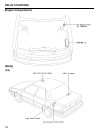
10
TROUBLESHOOTING
VOLTAGE CHECK
(a) Establish conditions in which voltage is present at the
check point.
Example:
– Ignition SW on
– Ignition SW and SW 1 on
– Ignition SW, SW 1 and Relay on (SW 2 off)
(b) Using a voltmeter, connect the negative lead to a good
ground point or negative battery terminal, and the
positive lead to the connector or component terminal.
This check can be done with a test light instead of a
voltmeter.
CONTINUITY AND RESISTANCE CHECK
(a) Disconnect the battery terminal or wire so there is no
voltage between the check points.
(b) Contact the two leads of an ohmmeter to each of the
check points.
If the circuit has diodes, reverse the two leads and check
again.
When contacting the negative lead to the diode positive side
and the positive lead to the negative side, there should be
continuity.
When contacting the two leads in reverse, there should be no
continuity.
(c) Use a volt/ohmmeter with high impedance (10 kΩ/V
minimum) for troubleshooting of the electrical circuit.


















